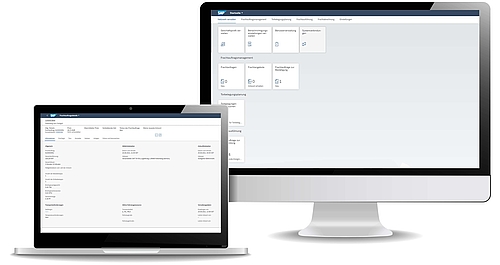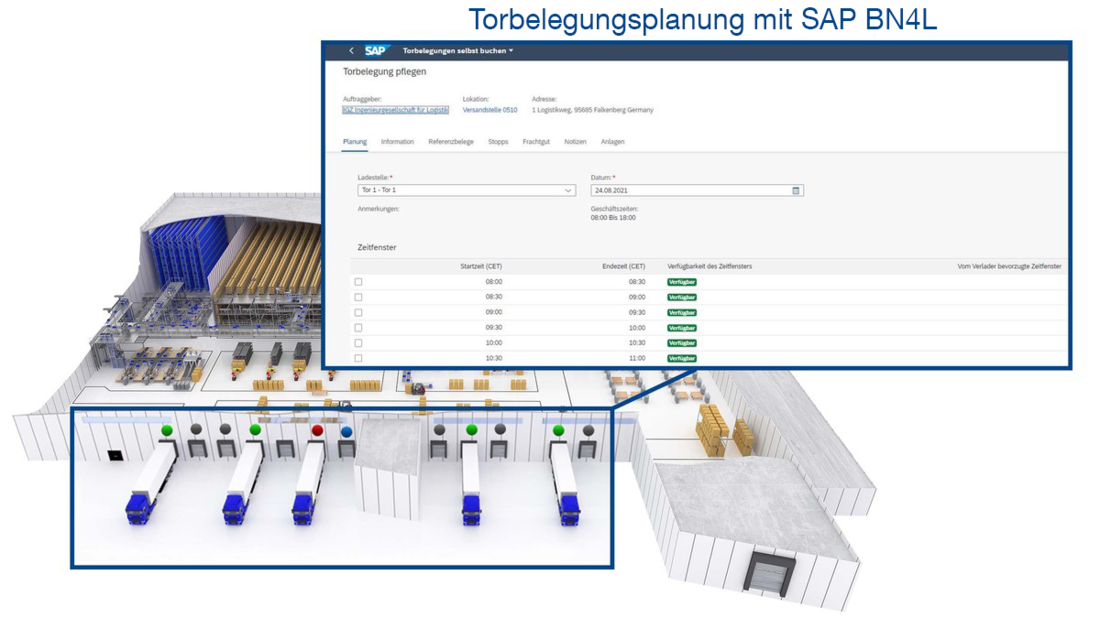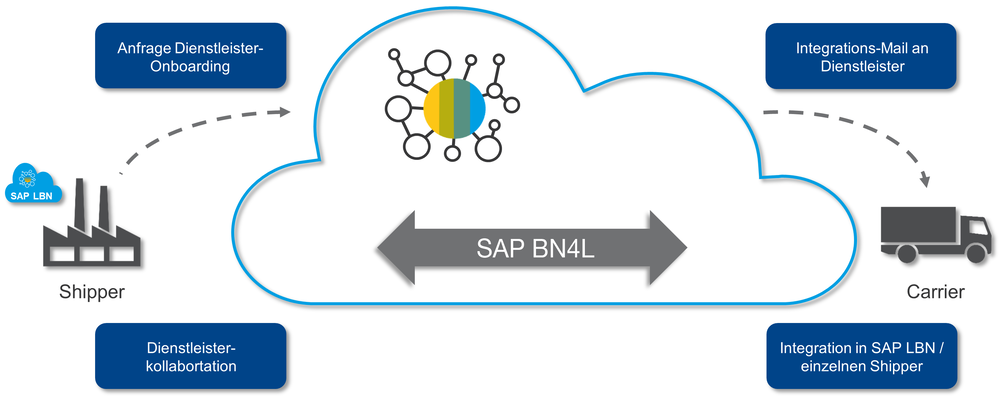SAP BN4L - SAP Business Network for Logistics Automated, collaborative order communication

Supply chain networks are becoming increasingly complex. This makes interaction between the players involved more difficult. There are also gaps in the traceability of goods during transportation. Loss of information can also result in poor route planning and rising freight costs. One solution to these challenges is SAP Business Network for Logistics (SAP BN4L).
The cloud-based module is part of the SAP Supply Chain Network (SAP SCN) platform and, in combination with SAP Transportation Management (SAP TM), is suitable for cross-divisional process optimization along the supply chain.
FAQ: Consistently networked transport control with SAP BN4L
SAP Business Network for Logistics (SAP BN4L) offers an open, central platform that enables shippers and logistics service providers to network easily and efficiently. The digital exchange of data and information simplifies collaboration and reduces the time required and costs incurred.
- End-to-end transparency across company boundaries
- Minimization of information loss
- Shortened response times
- Accelerated processing of transactions
- Possibility of continuous process optimization
SAP BN4L can be used in addition to SAP Transportation Management (SAP TM) to further exploit the potential of the cloud and realize cross-company communication and interaction in transportation planning and processing.
- Freight Collaboration - networked, automated order communication between shippers and freight forwarders
- Global Track & Trace - seamless end-to-end transparency along the entire supply chain
- Material Tracebility - blockchain-supported and role-based option for material traceability
Shippers integrate preferred carriers into their network and request a quote for the transport service to be provided if required. Selected transport service providers have access to all relevant information for order processing with just one click.
What exactly is SAP BN4L?
SAP Business Network for Logistics (SAP BN4L) enables seamless, end-to-end communication and interaction between the shipper/consignee and the connected external logistics service providers. Relevant information, such as freight orders and documents, are exchanged and jointly managed via this open, central platform. The system creates end-to-end transparency in real time and thus makes a decisive contribution to the reliable planning and constant optimization of transport and logistics processes, taking current requirements into account. This form of automated or end-to-end digital order management and control simplifies the management of each individual transaction.
In addition, SAP BN4L enables both transport service providers and clients (recipients and/or consignors) to plan and book loading and unloading times interactively directly in the system.
What advantages does SAP BN4L offer?
Internal stand-alone solutions for order processing are dissolved, standardized and combined on one platform without barriers. Among other things, the software supports freight tendering and the procurement of required capacities, transport planning, booking of delivery gates and invoice verification.
All participants in the network have direct access via a standardized interface and can access a constantly updated and consistent database. They can exchange information with other partners at any time and process necessary transactions without having to access third-party providers or being dependent on time and location. Ad hoc transports can also be realized quickly and efficiently.

How do SAP BN4L and SAP TM complement each other?
SAP Transportation Management(SAP TM) is the central transportation management system for transportation planning and execution as well as freight cost management. With SAP BN4L, SAP SE is refining the focus on networked, cross-company digitalized communication and collaboration between clients and carriers in the cloud. Access is role-based. Misinterpretations are virtually eliminated thanks to the structured exchange of information on the current processing status.
The full potential of SAP Business Network for Logistics is unlocked in combination with SAP TM. The cloud platform provides three additional applications: "Freight Collaboration", "Global Track & Trace" and "Material Tracebility". This allows dispatchers to create an order in SAP TM (which is integrated into the SAP S/4HANA core) without middleware and send their search query directly to SAP BN4L if they need a suitable transport service provider. If a freight forwarder has sufficient capacity, this can be confirmed ad hoc by submitting an offer via the platform. This information is visualized in SAP TM, the dispatcher can accept the offer and initiate the order. In addition to this transport tendering option, the necessary communication for freight cost clarification management can also be mapped directly via SAP BN4L. This allows freight forwarders to make their freight invoices directly available to customers in digital form. They can then approvethe invoice total after checking the amounts or initiate clarification management with SAP TM and SAP BN4L.
How are transportation service providers connected to SAP BN4L?
SAP Business Network for Logistics (SAP BN4L) follows the principle of an open, cloud-based system architecture. Shippers or users of the platform can freely design their network by creating a central partner directory and integrating selected logistics service providers into the community by assigning roles via a standardized interface. Freight forwarders can join by invitation and work together with the customer on an order-related basis. Access to stored information is either stationary or mobile via a single central access point.
In addition to this integration option, SAP offers a large standardized platform for service provider collaboration through selected partnerships that have service provider content.

What are the central functions in SAP BN4L?
Freight Collaboration
This function is based on the fundamental principle of SAP BN4L: connecting business partners from the freight sector in a collaborative network. Here they can manage transactions with each other, exchange documents and benefit from shared knowledge. When shippers and freight forwarders work together, it is also possible to share information on individual process steps or the current status quo. The otherwise time-consuming search for a suitable logistics service provider is no longer necessary and a suitable freight forwarder is quickly available. In addition, the close cooperation helps to reduce the number of daily empty runs.
Global Track & Trace
This option creates the conditions for consistent end-to-end transparency across all processes along the supply chain. It enables constant traceability of objects, processes and events. The recorded tracking information is processed and securely stored in the cloud. Status quo messages can also be sent to the involved parties via an app. Rules can also be created that automatically trigger further measures relevant to the order context. In the event of delivery delays or other deviations, it is no longer necessary to inform partners as they are all notified of the incident in real time. The "supply chain visibility" gained also enables participants to continuously optimize processes.
Material Traceability
The "Material Traceability" function allows SAP BN4L users or authorized participants to trace goods back to the point of manufacture. This is done via SAP Cloud Platform Blockchain Service (SCP). Supported by blockchain technology, all information on the product history is provided seamlessly. This is particularly important for active shippers and freight forwarders in the food industry, which places especially high demands on traceability and quality assurance. SAP BN4L thus helps to meet the legal requirements. The status information is visible to all participants as soon as a product has left the factory. Previous process stations or downstream steps from the time of delivery are only known to the shipper.
What are the benefits for transport logistics?
In transportation management, paperless, automated order communication has several key benefits: it helps to reduce response times, speed up processes and prevent misunderstandings between shippers and carriers that can lead to loss of information.
With SAP Business Network for Logistics, you can create end-to-end visibility and make sound decisions based on real-time data and forecasts for dynamic yet efficient transportation logistics planning and execution. With SAP BN4L and through the network participants, individual processes that were previously handled independently within the company and had to be coordinated accordingly can now be handled jointly. This automated, seamless collaboration - or holistic control - increases the efficiency of the entire supply chain.


